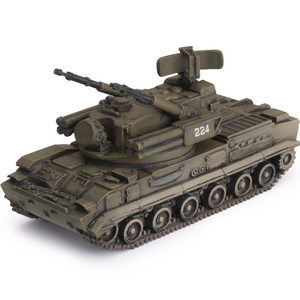SA-19 Grison

In Team Yankee
Announced by Battlefront. No game play information available.
https://www.team-yankee.com/hobby.aspx?art_id=6844
In Real Life
"Two Soviet generals are walking down the streets of Paris one day, Soviet troops marching towards the eiffel tower. One general turns to the other and asks "So, tell me, comrade, who won the Air War? "
- – An Army proverb
As the Cold War developed in the mid to late 1950s, it became clear to Soviet military planners that the Warsaw pact (Basically just the Soviet Union) couldn't build and sustain the same number and quality of military combat aircraft that NATO was able to produce.
This was both a result of the Soviets having simply less capacity to produce aircraft and the logistics of supporting them, but also because the Ground Forces had a strong funding and manpower precedence over the other arms of the armed forces.
While this doesn't mean the Soviet airforce wasn't funded at all, it did mean that it essentially ran off a proportionally smaller budget than the US Airforce has compared to the Army and Navy.
As a result, the Soviet ground forces found themselves taking up a larger proportion of air defence duties than the airforces did in western nations, and came with more 'nuanced' ideas on the role of ground-based anti-air systems.
The early stages of this development lead to iconic Soviet weapons like the ZSU-23-4 Shilka in the 1960s, but by the late 1960s the Soviets knew that they would need to build a new air defence system to accompany ground units and to provide point defence for larger strategic anti-air sites.
Lessons from the Vietnam War also taught the Soviets that in order to be effective, their SPAAG systems also needed a form of armament that can operate even when NATO air forces were operating SEAD (Suppression of Enemy Air Defense) Missions, which sees aircraft armed with 'Anti-Radiation Weapons' (Missiles designed to lock onto the radar emissions of enemy radar units and destroy them) try to locate and destroy Soviet anti-air vehicles and installations.
The result of the ensuing development is the 2K22 Tunguska, and it summarises how in several areas, despite their relative backwardness in computer technologies, the Soviets were able to produce world-class anti-air missile systems, often compensating for computational shortcomings with aerodynamic and metallurgical design as well as in doctrine.
By the mid 1980's, as the Tunguska was rolling off the production lines, the next generation of Soviet Anti-Air systems were rolling out ready to face the new battlefield of modern warfare in tandem with new American developments such as the MIM-104 Patriot system. In the modern-day the Tunguska has replaced it's predecessor, the ZSU-23-4, in Russian service though compared to it's 60's era predecessor, the Tunguska was not as widely exported with only about 7 countries outside of the Russian Federation actually having any.
Although reports of the system being used in actual combat are scarce if non-existant, with a couple of the few known exceptions being in Syria against Iraeli airs raids, and in the South Ossetia War, it still presents a competent threat to any aircraft or munition that decides to enter its weapons range, even if sometimes when shooting things can go awry.
The 2S6 Tunguska 2K22 (NATO code SA-19 Grison) is a Russian-made self-propelled air defence system which combines 30mm cannon and missile armament.
| Soviet Forces in Team Yankee | |
|---|---|
| Tanks: | T55AM2 - T-62M - T-64 - T-72 - T-80 - T-72B - T-64BV |
| Transports: | BTR-60 - BMP-1 - BMP-2 - BMP-3 -BMD-1 - BMD-2 - BTR-D |
| Troops: | Motor Rifle Company - Hind Assault Landing Company - Afghansty Air Assault Company - BMP Shock Motor Rifle Company - BMD Air Assault Company - Afghansty BMD Air Assault Platoon |
| Artillery: | 2S1 Carnation - 2S3 Acacia - BM-21 Hail - TOS-1 Buratino - BM-27 Uragan - 2S9 Nona - BM-37 82mm mortar platoon |
| Anti-Aircraft: | ZSU 23-4 Shilka - SA-13 Gopher - SA-9 Gaskin - SA-8 Gecko - 2S6 Tunguska - BTR-ZD |
| Tank Hunters: | Spandrel - Storm - BTR-RD - ASU-85 |
| Recon: | BMP-1 OP - BRDM-2 |
| Aircraft: | SU-22 Fitter - SU-25 Frogfoot - MI-24 Hind |